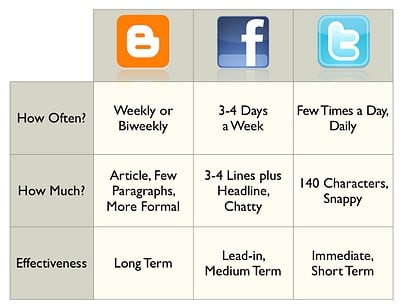Tracking Social Media ROI Part 3

Hello and welcome to the final installment of the Ashop blog’s post series on tracking the Return on Investment on your social media efforts. In our first two posts we discussed the kinds of metrics that best reflect social ROI, as well as the best methods and tools for finding it. Today, we’re going to switch gears a bit, and talk about some of the best ways to improve you social returns.
Improving Social ROI is all about effective content marketing which has three main pillars of success.
- Relevant and effective content
- Consumer Engagement
- Cohesive and cooperative strategy.
Content Marketing
The content that you provide for your various social media outlets should first work to align your brand with the goals and expectations of your audience. Second, it should explain the beneficial nature of something that your business does. Finally, if at all possible your content should always intrigue and incite your audience into traveling further down the sales funnel. Even if it’s only a step or two. This final point is the most important, yet somewhat less tangible than the first two.Drawing people into your sales funnel, doesn’t mean you need to convert a blog reader into a lead, or a lead into a subscriber. It means advancing your brand in any way possible to any degree possible. This can be something as simple as educating your audience as to your services and your online presence. As long as you’re staying active and positive within their spheres of attention, your content is doing its job, and will eventually show up in your social ROI metrics.
This is partly why many companies and marketers have such difficulty in seeing social media as a measurable activity. Because often the results of the relationships you build through content marketing on social media platforms won’t become visible or measurable for quite some time. This being the case, it’s very difficult to say what kind of impact social media efforts will have long term.
Because social media marketing is going on concurrently with all of your other more immediate marketing efforts, it can be quite difficult to nail down a specific boost in sales or profit margin as a direct result of a single social campaign. While these results can occasionally be obvious, (in such cases as promoting a specific coupon code through a single social network) they are often more subtle. This is because your shared content is always working to expand your brand, even when you’re not necessarily looking.
Once a good piece of content is posted, it gets passed around and shared by your followers. Many may look at the content, and simply keep the information contained therein in mind for use at a later date. Then, after seeing multiple pieces of content that all grab their attention, they begin to warm to the idea of purchasing from your online store. Think of effective content marketing like an avalanche. It doesn’t start as anything but a single snowflake that’s trying to gather momentum. Slow at first, the flake eventually becomes a ball, and then it gets rolling. Eventually, there comes a tipping point, and the whole snow drift is in motion.
In the same way, you may grab a visitor’s attention with a single post. He or she might think of the post haphazardly, or bring it up in a conversation with a friend. Once they’ve been reminded, they’ll revisit your page, and begin to take your brand more seriously. At a certain point, the visitor becomes a follower, and the momentum gets going. The follower becomes a buyer, and then spreads positive word about your brand. They share your content, and become return business, drawing other visitors into your sales funnel with their enthusiasm. Eventually a single piece of content that an individual visitor made a connection to can be responsible for a large contingent of conversions for your site.
And unfortunately, you’ll never truly be able to measure that effect, or track it back to its original source except in aggregate.
But that is why we spent the last two posts talking about the right metrics to measure and how best to measure them. Because social media marketing is so elusive, it’s important to find the most comprehensive ways possible to measure online activity that results directly from content shared across social networks.
Consumer Engagement
The second aspect of social media marketing is consumer engagement. We touched on this a bit in the last section already. This objective is the true key to social media success. By building relationships with consumers, you can ensure their engagement with your brand. Asking and answering questions, promoting interactivity, and simply participating in conversations with your customers will undoubtedly increase your social media ROI.This point can’t be overemphasized. People crave interaction. Social media suits humanity because we are social creatures. Even the most devout introvert can’t truly thrive in isolation. We all innately long for attention, adoration, and the interest of our fellow man.
As a seller and an online presence, you have the ability to provide all of that coveted social value to anyone who walks into your corner of the internet. By doing so, you not only earn yourself conversions, but your make a difference in individual lives. By engaging customers, in a small way you provide for them a sort of purpose. They have something to do because you’ve asked them a direct question. For a brief moment, their attention is entirely focused on the conversation that you’re having, and they’re usually enjoying the distraction.
Otherwise, they wouldn’t be involved in the first place.
I don’t mean to romanticize this largely impersonal business relationship that you’ll form with your online followers. Rather, I’m trying to paint you a picture of what the perfect buyer/seller arrangement can be. People are bored, they browse online to be educated, entertained, and engaged. If you can provide any or all of those objectives for them, gratitude is sure to follow. Gratitude is a powerful emotion that can be translated to profits in very short order. Online commerce isn’t just you convincing people to part with their money. It’s building a measure of trust between yourself and other individuals, allowing the natural human instinct of barter and trade to take place in a mutually beneficial fashion.
Cohesive and Cooperative Strategy
The final caveat to improving your social media ROI is effective strategy. Many marketers treat social media marketing like a different animal altogether. They isolate their online presences and fail to recognize the benefit of cohesion across platforms. Because social media ROI is difficult to nail down, it becomes an exercise in isolated strategy.“Let’s tweak this facet of our Facebook marketing to see if it’s more effective than such and such strategy that we’ve employed elsewhere. “
This kind of experimentation can be very helpful. However, it’s important to note that when all of your marketing efforts are working toward the same goal, you’re more apt to get the best results. The ideas of social relationships and consumer engagement we just discussed translate nicely to the business end of things as well. You want your social marketing efforts to be working together as a united force in order to achieve the best results.
Just like people, marketing efforts work best when used in conjunction with one another. If you write a blog with good SEO, you’ll get more attention by promoting it on Twitter. Special advance notice offers included in your newsletters can and should be promoted after the fact across your social media accounts. But most importantly, the people working on campaigns that are specific to certain social media platforms need to be in constant communication with one another.
You want to be the many parts of the same body, all performing individual jobs that work toward one purpose. The key to doing this is simple organizational cohesion. So establish effective modes of communication within your organization and listen to the input that you get from your coworkers. Together, you’ll achieve far more than you ever could separately.
Actionable Practices to Increase Social ROI

By following the outline presented in the above ideas, you’ll create a powerful and effective online presence, a large contingent of social media followers, and an efficient strategy for reaching them. However, when it comes down to specifics you might still need a few easily duplicable practices to help you get started. So take a look at the following list and try to decide on the best courses of action for your online store’s specific strategy.
- No spam- Be careful how often you schedule your posts. You don’t want to oversaturate your follower’s feeds with constant updates. Try to keep a steady flow at predictable intervals
- Coupons-Always promote coupons with your social media accounts. We’ve mentioned this one a lot in this series, and that’s because it’s a seriously effective tactic.
- Geo-Targeting with Twitter- Twitter allows you to target followers specifically by region. Mine this data, and use it to your advantage with region specific promotions.
- Join/Start Groups on LinkedIn- Groups allow you to intermingle with other LinkedIn users, despite the fact that you aren’t directly connected to them. If you join groups that are relevant to your niche, you can promote deals to their members.
- Know the Differences Between Pages and Profiles-Facebook and LinkedIn have Profiles for individual users and Pages for businesses. Make sure you start a Page not a Profile.
- Be Patient-Rome wasn’t built in a day. Don’t be discouraged if you don’t see immediate results from your social marketing campaigns. Remember the avalanche metaphor.
- Use Embedded Buttons to Easily Share Your Content-All of your content should have a “Tweet” or “Share” button so that viewers can quickly repost/retweet/re-blog/re-pin / etc. your content.
- No Hard Selling-There’s a time and a place for everything. Don’t send a sales letter over your social networks. People don’t appreciate the hard sells when they are trying to browse for helpful or informative content.
- Share other people’s content- Share and share alike, right? Spreading other people’s content helps establish you as a helpful resource, and engenders gratitude on the part of the original poster. You remember how effective a motivator gratitude can be, don’t you?
- Don’t be afraid to repost-You’re allowed to repost your own content. It doesn’t matter if it’s old, so long as it’s still relevant. Not everybody saw it the first time, so put it up again. Just be careful not to overuse the same piece. That will border on the edge of spamming.














Comment(s)0